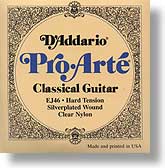Bass guitar tuning
In a Niibori Guitar Orchestra, the bass is tuned 4 notes down from the prime guitar. This means that the tuning is B E A D F# B.
The guitar is notated as if it were tuned conventionally, so that the instruction to play the open first string is written as an instruction to play E. When played, a B comes out, 4 notes higher.
What this means...
The bass guitar reads from the same notation as classical (prime) guitar, and is played with the same technique - nothing is different except that the notes come out lower in pitch than the notation suggests. Once the bass is tuned, the different tuning can be forgotten about.
When the composer/arranger notates the bass part, the bass guitar plays from a score with one less sharp, or one more flat, than the prime guitar.
 |
 |
 |
 |
|
| Pluck this | To hear this | To hear this | Pluck this |
Bass guitar strings

Because the classical bass guitar is not proportionately as large (compared to the prime) as the increase in depth of its open strings, the bass strings are thicker than the corresponding prime strings. Click for comparison table.
The bass strings require a heavy over-winding (to bring the pitch down while keeping the tension high enough to avoid 'slap'). This means that only two strings are monofilament nylon.
hago use D'Addario strings, discarding the top E string and moving all the strings up one. A D'Addario 0.054 single string is the new 6th string. This means that all the strings are tuned almost exactly to their prime pitches, although stretched over a slightly longer scale length. The additional scale length requires a tighter string, else it will slap back because its vibrating arc would be larger. Taken together it's a particularly cost-effective way to string the bass.